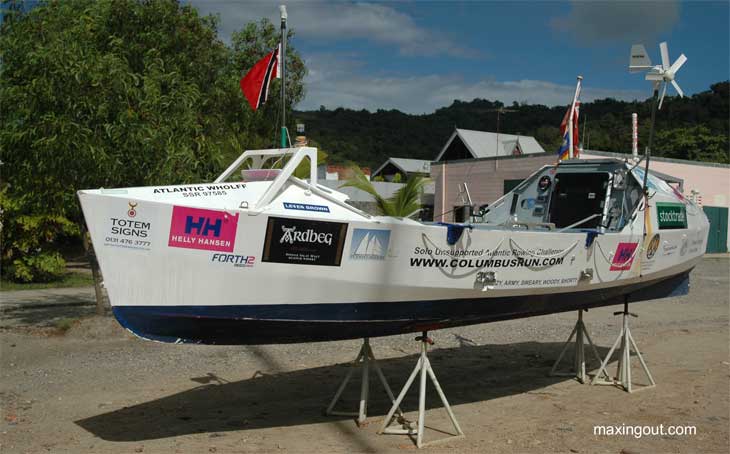Cracked.com, and one section elaborates a mysterious and incredible discovery of Roman relics in South America:
http://www.cracked.com/article_19769_5- ... z1shEYGXaU
The article further mentions a possible origin of the Roman statue in the burial ground with a discovery in 1982 by another archaeologist, Robert Marx, in the harbor of Rio de Janeiro: First, a load of Third Century Roman vases, and shockingly when he dug further, Two Roman-style ships, rotting at the bottom of the Brazilian coast..In 1933, an archaeologist was digging around a burial ground about 40 miles away from Mexico City when he discovered this tiny little figure [A Roman statue head] among the other offerings. And we should mention that this wasn't just a typical out-in-the-open burial dumping ground. The spot he was digging was previously under not one, but two undisturbed cement floors that were untouched since the 1500s. So it's not like a jokester could have purchased it at the nearest Roman-centered novelty store and dumped it in a cemetery to be hilarious.
And yes, we're aware that Columbus touched ground a few years before that, but white guys didn't make it to Mexico until 1519, and even then, it's unlikely they would have been carrying around Roman artifacts. And yes, they know it was Roman -- the beehive bouffant (or hat) and facial features match Roman artifacts of the second century.
So how did it get there? No one knows.
Why is this not well known?
Well:
http://www.nytimes.com/1985/06/25/scien ... razil.html
Needless to say, many people are not pleased. I am certainly frothing with rage at this.UNDERWATER EXPLORING IS BANNED IN BRAZIL
By MARLISE SIMONS
Published: June 25, 1985
SIGN IN TO E-MAIL
RIO DE JANEIRO— A DISPUTE between the Brazilian Navy and an American marine archeologist has led Brazil to bar the diver from entering the country and to place a ban on all underwater exploration.
The dispute involves Robert Marx, a Florida author and treasure hunter, who asserts that the Brazilian Navy dumped a thick layer of silt on the remains of a Roman vessel that he discovered inside Rio de Janeiro's bay.
The reason he gave for the Navy's action was that proof of a Roman presence would require Brazil to rewrite its recorded history, which has the Portuguese navigator Pedro Alvares Cabral discovering the country in 1500.
The Brazilian Navy has denied that it covered up the site and has in turn charged Mr. Marx with ''contraband'' of objects recovered from other wrecks in this country. Because of this, Navy officials said, the Government had issued an order ''to prohibit him from entering Brazil.''
To substantiate these charges, the Brazilian officials showed a catalogue of an auction held in Amsterdam in 1983 in which, they said, gold coins, instruments and artifacts removed from shipwrecks in Brazil were offered for sale on behalf of Mr. Marx and his associates. The officials said many of these objects had not been reported on the divers' inventory, contrary to an agreement with Mr. Marx.
'Don't Bother Me'
Several attempts to give Mr. Marx the opportunity to respond to these charges were unsuccessful. One phone call ended abruptly when Mr Marx said, ''Don't bother me,'' and then hung up.
All other permits for underwater exploration and digging, a prolific field in Brazil, have been canceled as a result of the Marx controversy and none will be issued until Congress passes new legislation, Navy officials said. Although the decision was taken a year ago, it was not publicized and only became known as a result of new inquiries into the Marx case.
The ban has affected a number of projects in Brazil's harbors and along its 4,600-mile coastline. Mainly foreign diving teams have discovered a panoply of gold and silver objects, but most of the sites, though known, remain unexplored.
In Guanabara Bay of Rio de Janeiro, more than 100 English, French and Portuguese shipwrecks lie unexplored like the pages of an unread, underwater history book.
But few spots seem to have aroused as much interest and intrigue here as the remains of a ship that struck a reef some 15 miles inside Rio de Janeiro's bay.
The story goes back to 1976 when lobster divers first found potsherds studded with barnacles just off Governor's Island in the bay. Then a Brazilian diver brought up two complete jars with twin handles, tapering at the bottom, the kind that ancient Mediterranean peoples widely used for storage and are known as amphoras. Brazilian experts disagree over the age of the jars, which have been turned over to the Navy and stored them in a warehouse.
Mr. Marx, who has long sought to prove that other sailors reached the Americas well before Columbus, obtained permission to explore the site in late 1982. Diving at a depth of about 90 feet, he found the parts of perhaps 200 broken amphoras and several complete ones, he said in an earlier telephone interview.
According to Elizabeth Will, a professor of classics and specialist in ancient Roman amphoras at the University of Massachusetts at Amherst, the jars are very similar to the ones produced at Kouass, a Roman Empire colony that was a center for amphora-making on the Atlantic coast of Morocco.
Reached by telephone, Professor Will said of the fragments she had studied: ''They look to be ancient and because of the profile, the thin-walled fabric and the shape of the rims I suggested they belong to the third century A.D.''
After Mr. Marx and Dr. Harold Edgerton of the Massachusetts Institute of Technology had explored the site with acoustical echoes and long metal rods, Mr. Marx said he became convinced that, below the potsherds, they had found the remains of a wooden wreck. A Roman vessel, he argued, had been blown off its course and reached Brazil.
Mr. Marx's expeditions received wide press coverage in Brazil, with some reports asserting that he was perpetrating a hoax and was defaming the name of the Portuguese discoverers of Brazil. Adding to the stir, a wealthy businessman, Americo Santarelli, claimed the amphoras as his property. He said he once had taken such a liking to some ancient Sicilian amphoras that he ordered a potter in Portugal to make exact replicas. To ''age'' the jars, he said, he dropped 16 of them in Guanabara Bay in 1961, but collected only four.
In January 1983, when Mr. Marx returned to Brazil to start salvaging the wooden wreck, he said, the tides had turned. ''The Navy people I worked with told me the Navy had covered up the site to keep it from being plundered,'' he said. ''They also said this thing is causing so much controversy, it's better if you leave.''
Mr. Marx said he nonetheless went diving and found that the spot where objects had been close to the mud surface was now covered by a large mound. He added that other Government officials then told him: ''Brazilians don't care about the past. And they don't want to replace Cabral as the discoverer.''
At the Captaincy of the Port, a division of the Navy, officials said there was no record of the site being covered over. They added, however, that ''any operation in the bay'' could only have been carried out with the knowledge and permission of their office. Other Navy officials also said there had been no ''cover-up.''
But the fact remains - there are evidence to suggest that the Romans MIGHT had been to the South Americas before, they MIGHT had been there deliberately or by accident, they MIGHT had beaten Columbus, Cabral or even the Chinese and the Vikings to the New World. We can't tell for sure since the evidence are either not well-known or deliberately covered up, but they still exist; if you want them found, look no further than the biggest of them, still buried under the sands somewhere in Rio De Jainero's bay, with potential of becoming one of the History's biggest Pandora's Jar.
One thing is certain - if confirmed, our understanding of the past of both the Mediterranean and the New World as we know it will be thrown upside and down.


